This guest opinion is by Paxton Rothwell.
“NE 7th fails to be either a vehicle through route or a bike-friendly neighborhood street. And yet it remains popular as both.”
Traffic issues on NE 7th Avenue are once again in the spotlight. As BikePortland reported, the neighborhood meeting held September 14th did more to ignite additional concerns about the safety of the street than it quelled. PBOT has suggested new traffic calming measures in the vicinity of NE 7th and Tillamook to try and make peace with this coalition of neighbors. From the looks of it though, the larger conversation about the safety of NE 7th is back on the table.
I have lived in the King neighborhood for almost four years. During that time, I have become intimately familiar with NE 7th Ave. But, like some of the concerned neighbors I met at the meeting with PBOT this week, I did not live in this area of the city when discussions about the Lloyd to Woodlawn greenway were being held back in 2018.
The political temperature of Portland has changed a lot in the last four years. Those opposing the changes proposed to 7th back in 2018 may have had a change of heart. The only way to know is if PBOT continues the larger conversation about 7th.
In anticipation of that conversation, I want to present 7th Ave as it is today and some design options that would make it a safer street for cycling, walking, and driving.
Current Conditions
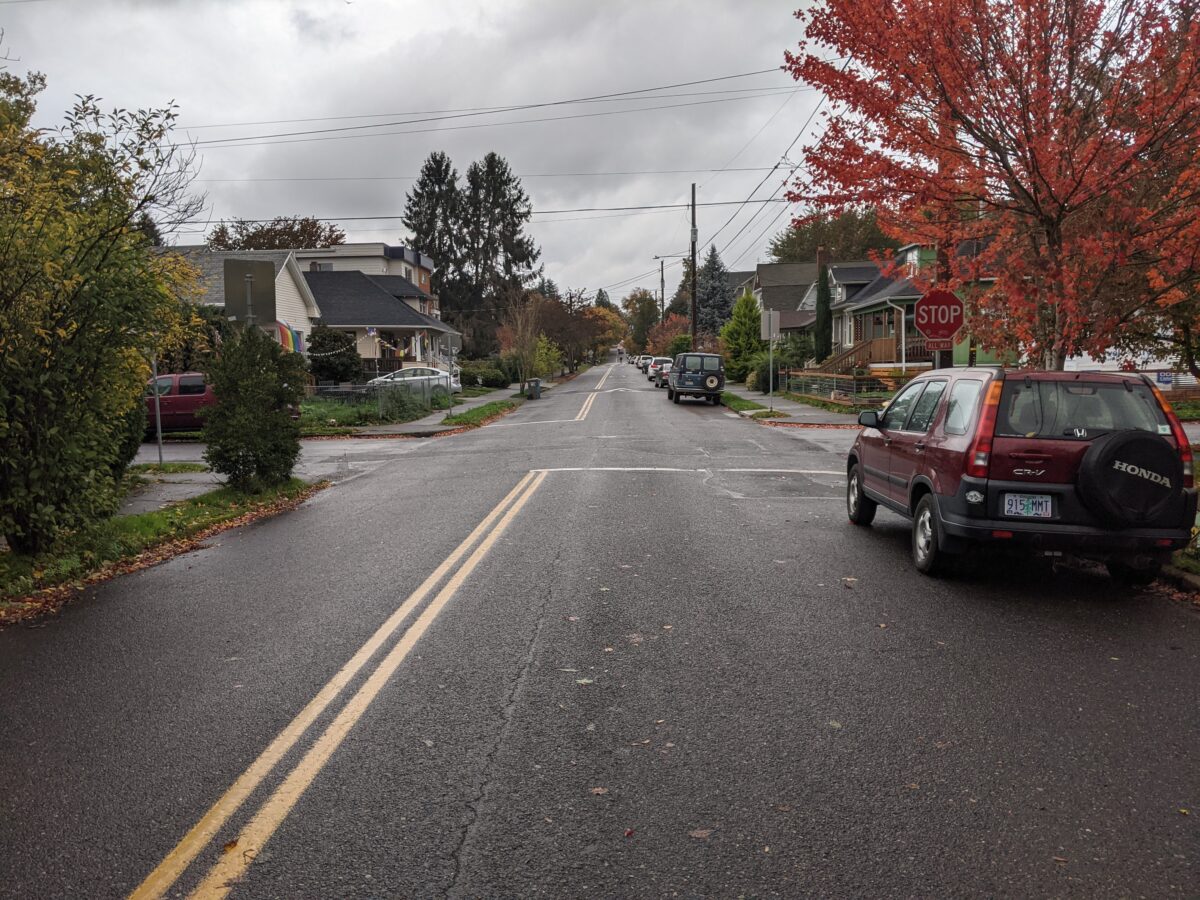
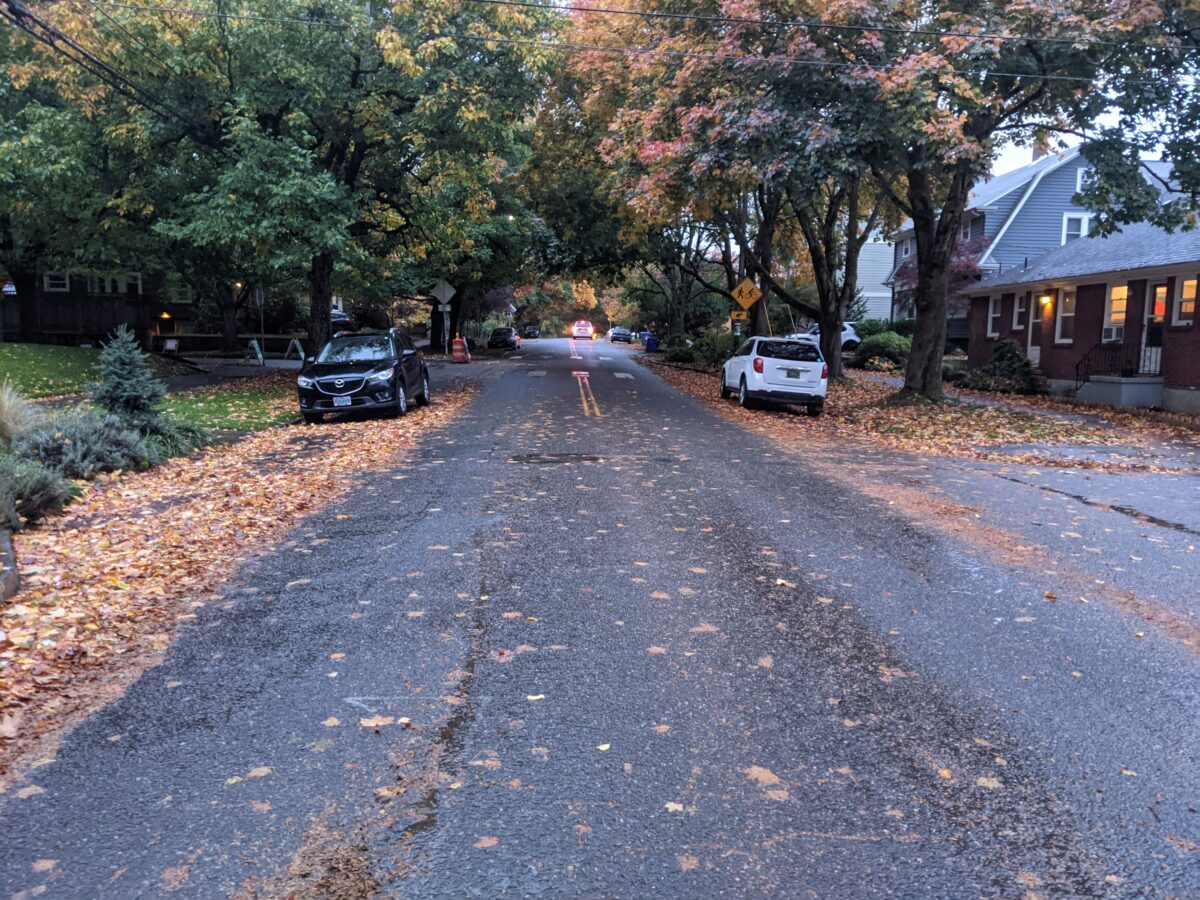
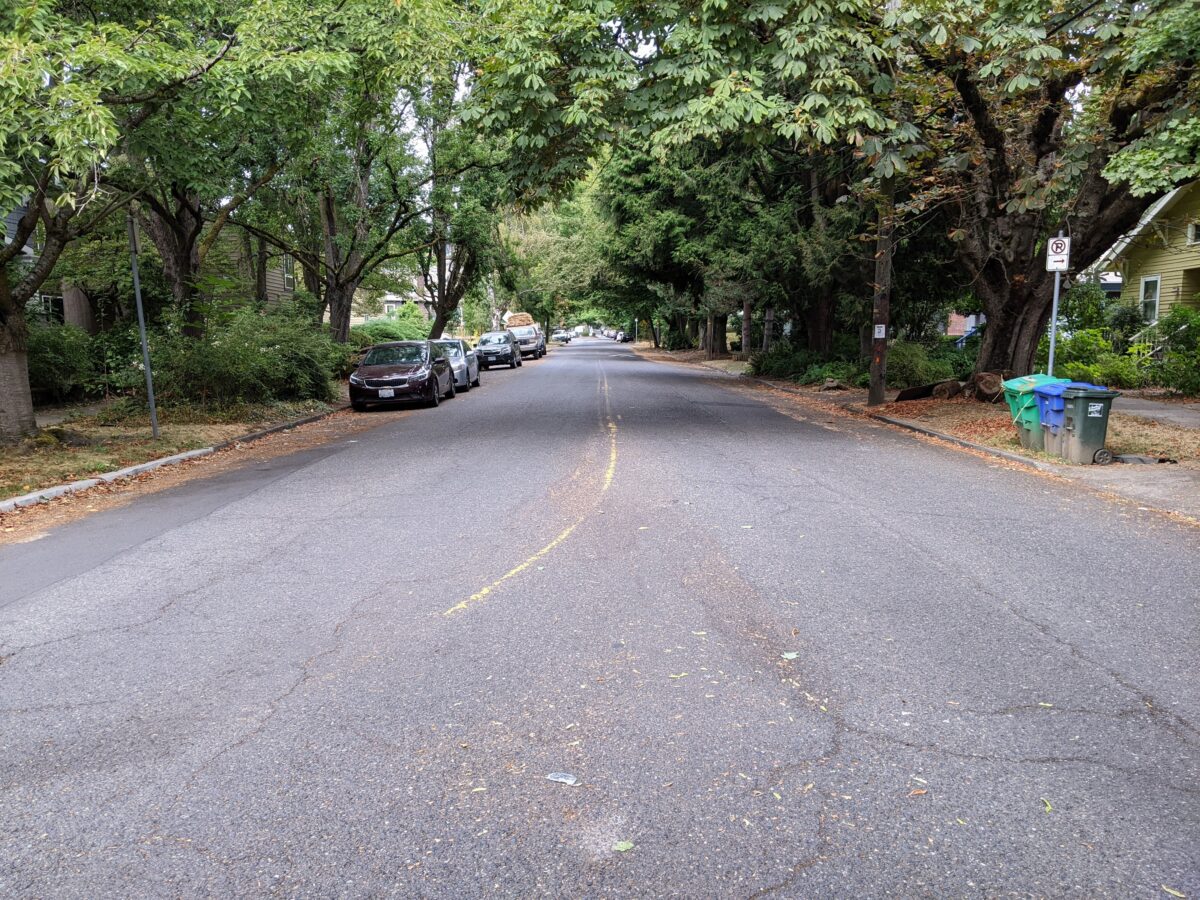
I frequently use 7th as a biking route, walking route, and even as a driving route. As a cyclist I often fear the uphill (northbound) ride, especially at night, because of poor lighting, many potholes, and close passes from drivers. As a driver on 7th, I feel out of place. The street has the feel of a neighborhood street that I should not be on for too long. But it also has traffic signals at major intersections and a defined center line. The design of NE 7th fails to be either a vehicle through route or a bike-friendly neighborhood street. And yet it remains popular as both.
NE 7th parallels MLK Jr. Blvd (a state highway) for its entire length. Since it is only 400 feet away, MLK ought to be the sole through route for drivers. But the current design of 7th welcomes drivers and offers an alternative to congestion on MLK. Keeping this vehicular redundancy flies in the face of the City’s own goals of reducing vehicle trips and increasing cycling trips by 2030.
The second the Blumenauer Bridge opened 7th Avenue became a de facto north-south bike route from Alberta to Division. There are city projects in the works to improve the 7th greenway from Sandy to the Bridge. There is also a Metro funding decision (pdf) in progress to see if 7th through the Central Eastside will be rebuilt into a complete street. To make this street a true biking thoroughfare, PBOT must discourage drivers from using 7th between Alberta and Broadway.
Here are some ways to do that.
1) One Way Vehicles, Two Way Cycle Track

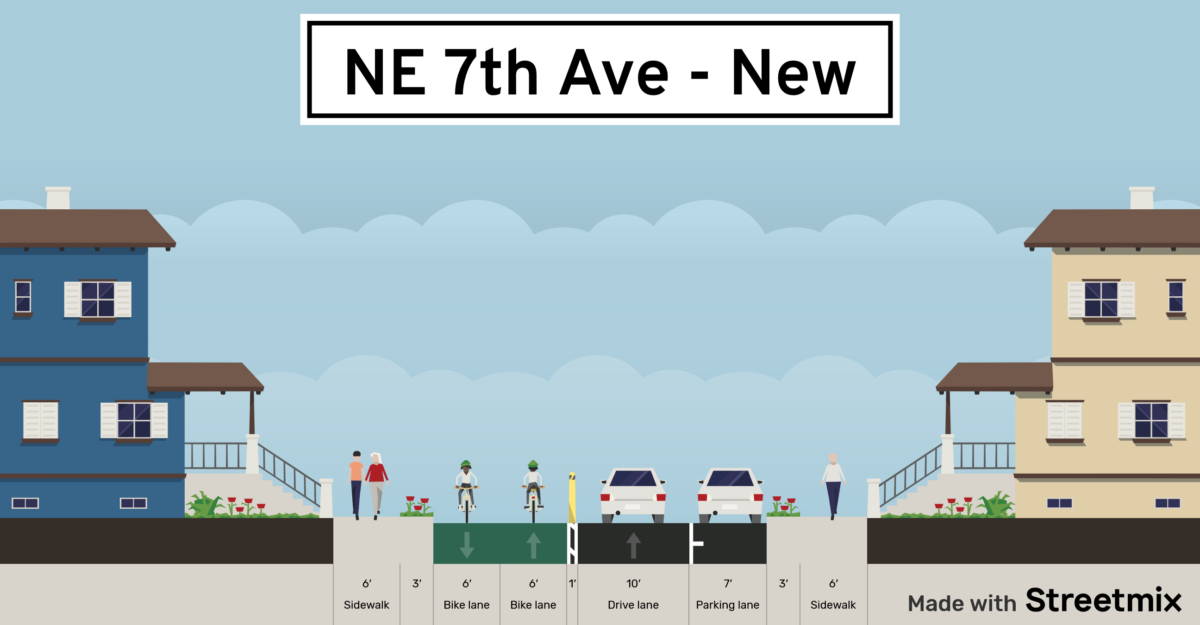
Similar to Better Naito, this design would provide a continuous two way cycletrack from Broadway to Alberta. Vehicle traffic would be one way but could alternate in direction to discourage through travel. Some on street parking would be lost. A section of 7th near Irving Park would remain two way for vehicles due to the break in the street grid caused by the park. This design could face pushback because of its boldness, but would do the most to make 7th a world class bike boulevard. Below are cross sections of 7th for the configuration north of Fremont St.
2) Two Way Vehicles with Advisory Bike Lanes and Diverters
Similar to recent installations in northeast Portland, this design would remove the center line of NE 7th, narrow the driving lanes, and place an advisory bike lane on both sides of the street. Minimal on street parking would be lost. This design would also add diverters at key intersections to keep traffic volumes low. This design would provide a reasonable compromise between local drivers interested in keeping driving possible on 7th and non-vehicle users who want a safer street.
3) Two Way Vehicles, Sharrows, and Diverters

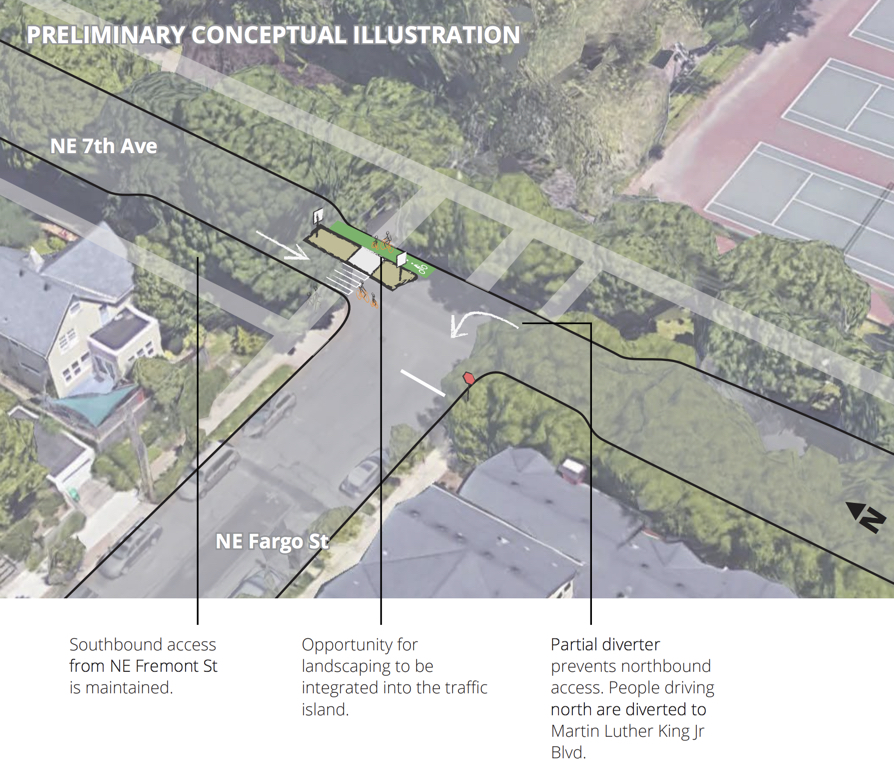

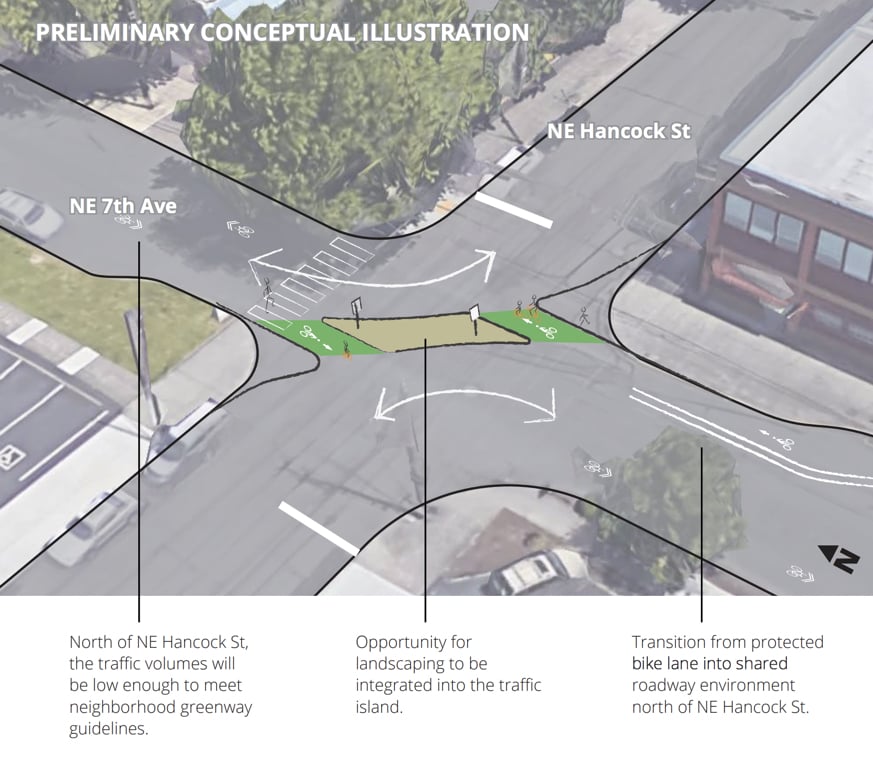
Similar to the Clinton Street greenway, this design would remove the center line of NE 7th, add sharrows to the roadway, and place frequent diverters to direct vehicle traffic off of the street. Minimal on street parking would be lost. This design would be the most similar to how NE 7th is today and would provide little dedicated cycling space. But with frequent diversion, the hope would be to discourage drivers from using 7th. When the Lloyd to Woodlawn greenway routing was still in talks in 2018, PBOT released diversion concepts for a few intersections (see below).
Continuing the conversation about 7th Ave seems likely. Let us hope that PBOT boldly engages the community this time around.






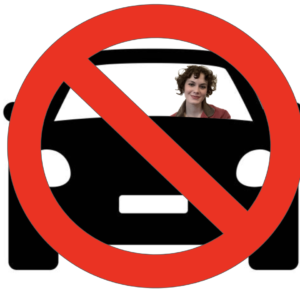
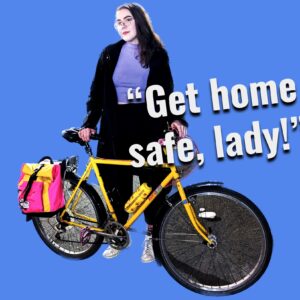
Thanks for reading.
BikePortland has served this community with independent community journalism since 2005. We rely on subscriptions from readers like you to survive. Your financial support is vital in keeping this valuable resource alive and well.
Please subscribe today to strengthen and expand our work.
The intersection of Tillamook and NE 7th is currently closed to car traffic due to the barricades set up for the construction project. This has given us an idea of what NE 7th would be like with diversion of car traffic.
I live in Northeast and have always avoided 7th, instead taking 26th or Williams/Vancouver. I’ve tried 9th but the pavement is bad and there are several extra hills, and it’s difficult to connect through Irving park
But the last few days I’ve taken 7th several times, including riding with my 12 year old daughter to visit a friend in Northwest. It’s been much nicer with greatly reduced through traffic south of Knott. This would be a great family-friendly route with some changes.
I understand that there a business at the corner of 7th and Knott and at 7th and Fremont which want to maintain access. But if there is a diverter near Tillamook and between Siskiyou and Morris (the two places where east-west bike route have to turn onto 7th for a block), I think that would be enough to reduce car traffic while still providing business access near the main intersections. Perhaps the prior plans to extend Two Plum Park, between Mason and Shaver, would also be needed.
It is conceivable that with sufficient speed bumps, auto traffic can be slowed to something approximating the speed limit, which, even without diversion, would help it feel like a sane place to ride. We all know that diversion here is controversial, so solutions that avoid it and preserve auto access are more likely to get past the PBOT filter.
Anyone know if 7th is an emergency vehicle street?
Not related to the topic of the article itself, but I love reading guest opinions from people who live in neighborhoods about conditions in their area. Would love to see more of these.
Welcome to the neighborhood, Paxton! Thanks so much for sharing these ideas. I want to respond to a few things you said:
I definitely agree that the conversations are continuing–I’ve ridden my bike through the NE 7th/Tillamook intersection several times in the past week and noticed folks out there talking, even beyond the well-attended meeting with PBOT.
But, I don’t think this is an engineering problem. And I disagree that the only way to know if folks have changed their mind is for PBOT to continue the conversation.
Right now in Portland, the best way for citizens to advocate for change is to make sure we have a diverse array of people supporting that change along with us. This is a lot of work! It means that if you want bike lanes on a street, you have to lobby the businesses on the street, not just PBOT. So, if you know there are businesses that aren’t in favor of diverters, go talk to them.
And, most importantly, here in historic Albina, we can’t — and shouldn’t — expect any kind of change if our Black neighbors don’t want that change. This isn’t on PBOT. This is on those of us who want those changes. Our Black neighbors asked for safety improvements for years and didn’t get them. Some are understandably frustrated that these changes are coming with a continuing wave of gentrification. And while bicycling doesn’t cause gentrification, it is perceived that way.
I want to encourage bike people and Bike Portland readers and white folks living in and near Albina (Eliot, Boise, King, Sabin, Irvington) not to wait for PBOT. Rather, talk to our Black neighbors, especially those who have lived here for a long time, about what they’d like to see to make things safer. You might not like what they want, and you might want something else. But you might find out that there are similar interests, and that can be a great starting point for moving forward.
This is easy enough for me to say, as someone who isn’t advocating for these changes right now. But I think the effort to turn NE 7th into a greenway a few years ago likely would have been more successful if organizers and advocates had been more intentional and deliberate in reaching out to Black neighbors. I don’t mean to criticize their work, and they definitely had a lot of conversations with a diverse array of people. They worked very hard. But ultimately, our advocacy efforts in Albina need to center the voices of our neighbors whose voices have been ignored for years. For us to ignore their voices because we want a better bike route isn’t just, anymore than it was just for Oregon to plow a ditch through the neighborhood to build a monstrosity of a freeway.
This project isn’t going to move forward unless we acknowledge the problems of the past and are part of correcting them. I appreciate the creative design approaches shared here, and I appreciate all the folks who are passionately working to make this neighborhood safer for everyone.
Thanks Paxton and Big YES to bidirectional cycle lanes!
Yes, please for option #1! I really don’t understand the aversion to changing streets to one lane + one way to make ample, safe space for bikes and peds.
Excellent ideas that deserve to be discussed now, thank you Paxton!
Paxton, what do you mean by “hoping PBOT boldly engages?” Like since you have been on the street for four years boldly or the people who have lived there for generations that have been displaced at alarming rates so people could live here the last four years?